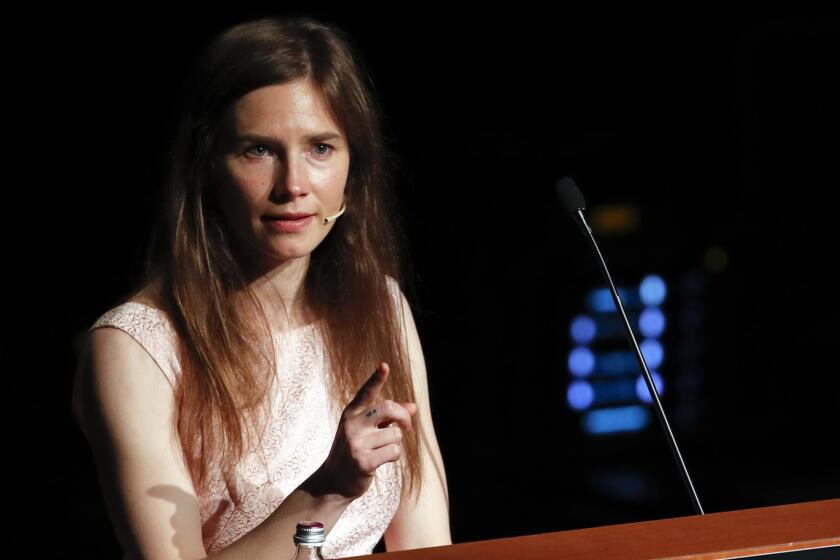Worth more than the paper it’s printed on
- Share via
It would be understandable to feel a little mystified wandering into the Karpeles Manuscript Library Museum in Santa Barbara. In a small stucco building with an aluminum mailbox by the front door, it doesn’t exactly look like a museum.
Marsha Karpeles, who founded the institution in the early 1980s with her husband, David, freely acknowledges it is eccentric. But what are you to do when your friends have all seen your world-class collection of rare maps and documents? You open a museum.
Or seven museums, in Santa Barbara; Tacoma, Wash.; Newburgh, N.Y.; Jacksonville, Fla.; Duluth, Minn.; Charleston, S.C.; and Buffalo, N.Y., where notable items from their collection are displayed in rotating exhibits. And there are 200 “mini-museums,” as the Karpeleses call them, in schools and office buildings around the U.S.
When I recently visited the Karpeleses at the museum in Santa Barbara, documents commemorating Black History Month filled the wooden cases, including a letter written in the careful hand of civil rights activist Rosa Parks. In April, the museum will open “Man’s Inhumanity to Man,” juxtaposing documents that evoke the darkest moments in history, such as a speech written by Adolf Hitler, with brighter reflections of mankind, including a letter written by Mohandas K. Gandhi.
David Karpeles, a tall, courtly man in his late 60s, is a mathematical analyst and real estate tycoon who met petite, energetic Marsha on a blind date. They’ve been married 46 years and have four grown children, and they are more like the down-to-earth retired couple next door than they are like, say, magnate and renowned manuscript collector J.P. Morgan, founder of Pierpont Morgan Library in New York.
Question: What made you start collecting?
David Karpeles: In 1977, we took two of our kids to the Huntington Library in San Marino. The kids had no interest whatever. We had two cases left to see when they started asking if we were ready to go. But then my daughter Leslie said, ‘Daddy, Daddy, here’s a letter written by Thomas Jefferson.’ My son Mark found one by George Washington and said excitedly, ‘Look at the cross-outs. He made mistakes just like me!’ They knew they were looking at originals famous people had touched, a completely different thing from just reading the documents. All of the sudden, everything changed for them.
At the library I was told that if I wanted to buy rare documents, I had to go to Sotheby’s or Christie’s auction houses.... So I sent away for catalogs. Most of the things for sale were unimportant, but then I turned a page and almost fell off my chair. It showed [one version of] the Emancipation Proclamation, signed by Abraham Lincoln, at an estimated sale price of $40,000. I got it for exactly that much, though now it’s worth $2 [million] to $3 million.
Question: Did you actually bid on it?
David Karpeles: No, I used a broker. I don’t travel much beyond Carpinteria. But once I went to New York to buy George Washington’s Thanksgiving Proclamation from a dealer. Walking down the street with it, I was so excited I was trembling in my boots.
Question: How did the museums get started?
Marsha Karpeles: We exhibited some manuscripts in Montecito in 1983, when a collection of purported Hitler diaries came to light. Kenneth Rendell, a rare manuscript expert who was analyzing them, contacted us because he wanted to see a couple of our Hitler speeches to help him make a verification. So we put on a Hitler exhibit and had him speak.
David Karpeles: In 1991, we opened a museum on Central Park West in New York, with an exhibition of the original 1787 draft of the Bill of Rights. Only 68 people came to see it. Then we took it to Jacksonville, Fla., where 5,000 people came in one day.
Question: Is that why you’ve chosen smaller cities as sites for the museums?
David Karpeles: We wanted places where the collection would be appreciated. About 125,000 people visit them a year and some -- for instance, the Buffalo museum -- are expanding. In Charleston, we chose a part of the city that was falling apart but is now gentrified.
Marsha Karpeles: The museums are spread across the country. We want kids all over to act like ours did that day at the Huntington.
Question: Why did you choose to open your own museums instead of lending manuscripts to other institutions?
David Karpeles: Lending is too dangerous. We know how to care for the documents. If they were damaged, we’d be reimbursed. But we don’t want the money.
Question: Some of the items displayed are copies. Why?
David Karpeles: Most are originals, but the rarest can’t be in the light for long periods of time. We show some of those for a few hours on special days.
Question: Which are your favorites?
David Karpeles: Mine is a decree by Pope Lucius III, dated 1183, instructing knights on their departure to the Holy Land for the Third Crusade.
Marsha Karpeles: I just got an MFA in creative writing, so mine is the first draft of the thesaurus created by Roget in 1805. He used it for many years without telling anyone about it. It wasn’t published until 1852.
Question: Collecting these things is important to you, isn’t it?
Marsha Karpeles: It’s like a religion.
The Karpeles Manuscript Library Museum, 21 W. Anapamu St., Santa Barbara; (805) 962-5322, www.karpeles.com. Admission to all of the museums is free.
More to Read
The biggest entertainment stories
Get our big stories about Hollywood, film, television, music, arts, culture and more right in your inbox as soon as they publish.
You may occasionally receive promotional content from the Los Angeles Times.










